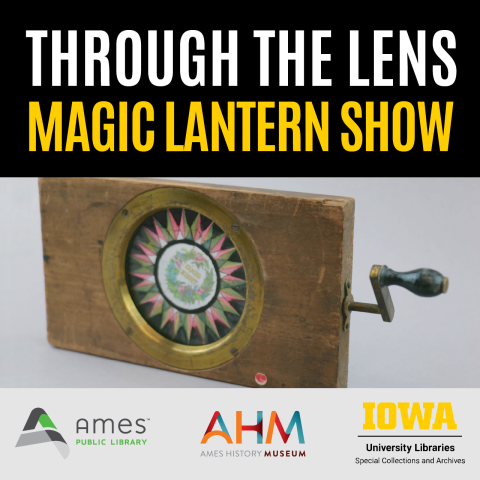
Illuminating the Past
by Cathy Cooney
Imagine you live in the 1800s. Your family read in the newspaper about a new form of entertainment and traveled in a wagon to the next town over. You hustle inside and gather closely with dozens of other excited participants, waiting for the show to begin. The lights go out. Suddenly, the room is filled with a bright, larger-than life image. How amazing!
The magic lantern was invented in the mid-1600s, but magic lantern shows became popular in the 1800s. Essentially an early type of slide projector, magic lanterns used a light source (like an oil lamp, candle, or bulb), a concave mirror, painted glass slides, and a lens to magnify and project images. Some slides were animated; They could be rotated to mimic kaleidoscopic patterns, shown through a second lens with an enhanced version of the slide to allow part of the image to “dissolve,” or the plates of glass could slide back and forth to illustrate movement.
As technology improved, photographs could also be printed on the plates, allowing people in rural places to see famous landmarks, historical figures, and important events. Some shows featured live music or narration alongside the images. In the days before motion pictures, television, and of course the internet, what an incredible feat!
If you found yourself enraptured by the description at the beginning of this article, come join us at the library for “Through the Lens: Magic Lantern Show!” On Thursday, May 29, historian Mike Zahs and librarian Elizabeth Riordan will present a recreation of a show and share more information about this historical form of entertainment.
Mike Zahs has been working with magic lantern materials for years, particularly with the collection of W.F. Brinton, a media entrepreneur from Washington, Iowa. Brinton’s collection is now housed at the University of Iowa Libraries’ Special Collection and Archives. If you’re interested in learning more about these fascinating materials, check out “Saving Brinton,” a documentary featuring Zahs’ work with Brinton’s collection.
Ames Public Library also has a display created by Elizabeth Riordan in the entryway vestibule this month featuring images from the collection and some additional history about magic lantern shows and W.F. Brinton. Both the program and the exhibit are presented in partnership with Ames Public Library, Ames History Museum, and University of Iowa Libraries’ Special Collections and Archives.